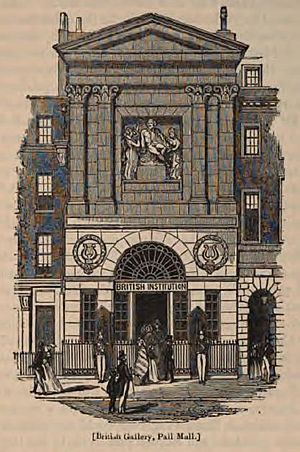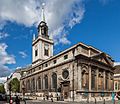George Dance the Younger facts for kids
Quick facts for kids
George Dance
|
|
|---|---|
| Born | 1 April 1741 Chiswell Street, London
|
| Died | 14 January 1825 (aged 83) Bloomsbury, London
|
| Nationality | British |
| Occupation | Architect |
| Awards | Royal Academician |
| Practice | |
| Buildings | Guildhall, London; Mansion House; Newgate Prison; Royal College of Surgeons; etc. |
| Projects | Barts Hospital; Commercial Road; Finsbury Circus & HAC HQ; Old Billingsgate Market; etc. |
George Dance the Younger (born April 1, 1741 – died January 14, 1825) was a famous English architect. He was also a surveyor and drew many portraits.
George was the youngest of five sons. His father, George Dance the Elder, was also a well-known architect. The Dance family had many artists and creative people. A famous historian, Sir John Summerson, said George Dance was "among the few really outstanding architects of the century." Sadly, not many of his buildings are still standing today.
Contents
Life of George Dance
Early Life and Education
George Dance was born in London on April 1, 1741. His family lived on Chiswell Street. He went to St Paul's School in London.
When he was 17, George traveled to Rome, Italy, in 1758. He spent six years there, until 1765. He studied architecture and drawing. His brother, Nathaniel, was already studying painting in Italy. They lived together in Rome.
In Rome, George met other important artists and architects. These included James Adam and Robert Mylne. He also met Giovanni Battista Piranesi, a famous artist whose work inspired Dance. George was a student at the Accademia di San Luca. He drew many famous buildings in Rome, like the Arch of Constantine. He even won a gold medal in a competition for his design of a public gallery.
His Career as an Architect
After returning to London in 1765, George Dance joined his father's architecture business. His first big project was rebuilding the All Hallows-on-the-Wall Church. He was chosen over four other architects. The church was finished in 1767.
In 1768, George's father passed away. George, who was only 27, took over his father's job. He became the Architect and Surveyor for the Corporation of London. This was a very important role.
Some of his most famous works in London include:
- Rebuilding Newgate Prison (started in 1770).
- Designing the front of the Guildhall in London.
- Rebuilding the Church of St Bartholomew the Less (1793).
Outside London, he designed the Theatre Royal in Bath. He also designed Coleorton Hall in Leicestershire. This was one of his few buildings in the Gothic style.
Many of Dance's buildings have been torn down. These include Newgate Prison and the Boydell Shakespeare Gallery. He stopped working as an architect in 1815.
Dance's work helped shape the Neo-Classical movement in architecture. He influenced other famous architects like Sir John Soane and Sir Robert Smirke. His designs for places like the Guildhall were very new and exciting.
The Royal Academy
George Dance was one of the first members of the Royal Academy. This important art institution was started on December 10, 1768. His brother Nathaniel was also a founder.
In 1798, Dance became a professor of architecture at the Royal Academy. However, he never gave any lectures. Because of this, he was removed from the position in 1805. His former student, Sir John Soane, took his place. George Dance was the last living original member of the Royal Academy for many years.
His Portrait Art
After 1798, George Dance focused more on art than architecture. He drew detailed pencil portraits of his friends. These friends were important artists in London.
A book called A Collection of Portraits was published from 1804 to 1814. It featured 72 etchings made from his drawings. Many of his original portraits are now kept at the National Portrait Gallery.
Personal Life
George Dance married Mary Gurnell in 1772. They had three sons: Thomas, George, and Charles. Mary passed away in 1791 when she was 38 years old.
Dance was not well for the last few years of his life. He died on January 14, 1825, at his home on Gower Street in London. He was buried at St Paul's Cathedral.
List of Major Works
Here are some of George Dance's most important architectural projects:
- All Hallows on the Wall Church, London (1765)
- Newgate Prison, London (1769–1777)
- Guildhall, London (various alterations and new façade, 1772–1806)
- Mansion House, London (alterations, 1782)
- St Luke's Hospital for Lunatics, Old Street, London (1780)
- Boydell Shakespeare Gallery, Pall Mall, London (1788)
- St Bartholomew the Less Church, London (rebuilt 1793)
- Royal College of Surgeons of England, London (rebuilt 1806 onwards)
- Wesley's Chapel, London (1778)
- Pitzhanger Manor, Ealing (Dance's own house, 1768)
- Cranbury Park, Hampshire (remodelling, 1776–81)
- Coleorton Hall, Leicestershire (1802)
- Stratton Park, Hampshire (1803)
- Theatre Royal, Bath (1804)
Images for kids
See also
- Ammonite Order



















